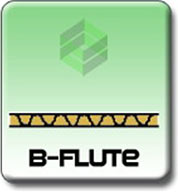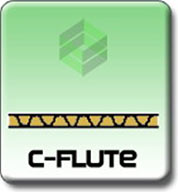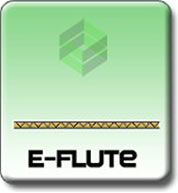Flutes Definition
The FLUTE describes the structure of the wave shaped cardboard material that makes up a board.
B flute cardboard structure
B-Flute
The second flute size adopted by the corrugated industry, has lower arch heights than A and more flutes per foot (50). This means that the medium contacts and supports the liners at a greater number of points, providing a stiff, flat surface for high quality printing and die cutting and with excellent crush resistant properties. B-Flute is also preferred for high speed, automatic packing lines and for pads, dividers, partitions and other forms of inner packing. Complex die cuts and beverage trays are excellent applications for B-Flute as are can cases, wrap-around blanks, glass-to-glass packs and slip sheets. B-Flute is generally combined with light weight liners but can be used with heavier facings if the need arises. This is a cross-section profile of the basic types of flutes.
C flute cardboard structure
C-Flute
C-Flute came along next to split the difference between A and B Flutes. With 42 flutes per foot, it’s thinner than A-flute,thicker than B, and offers good cushioning, stacking and printing properties. C-Flute is by far the most widely used flute size. An estimated 80% of today’s corrugated containers are made of C-Flute board.
E flute cardboard structure
E-Flute
E-Flute has the greatest number of flutes per foot at 94 which gives it the greatest crush resistance and the flattest surface for high quality printing applications. The thin board profile of E-Flute (it is one-fourth the thickness of C-Flute) reduces box size and saves storage space. Because of its thin profile and excellent cushioning properties, E-Flute can often substitute for conventional folding cartons or solid fiber containers. Examples of E-Flute applications include boxes for cosmetics, fragile glass and ceramic items and delicate instruments. Another growing end-use is for pizza boxes where the retailer wants a cost effective container with good graphics and excellent product protection.



